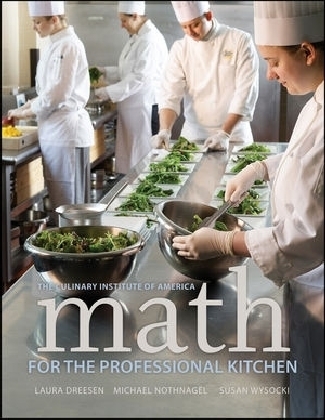
Math for the Professional Kitchen
John Wiley & Sons Inc (Verlag)
978-0-470-50896-1 (ISBN)
Essential math concepts for professional chefs and culinary students
Ideal for students and working professionals, Math for the Professional Kitchen explains all the essential mathematical skills needed to run a successful, profitable operation. From scaling recipes and converting units of measure to costing ingredients and setting menu prices, this book provides a thorough understanding of the crucial math concepts used in the restaurant and foodservice industry.
Written by three veteran math instructors from The Culinary Institute of America, the book utilizes a teaching methodology based on daily in-classroom practice. The entirety of the standard culinary math curriculum is covered, including conversions, determining yields, purchasing, portioning, and more.
Vital mathematical concepts are reinforced with easy-to-understand examples and review questions
The book is accompanied by instructor support materials including an Instructor's Manual, a Respondus test bank, and PowerPoint lecture notes
This is a thorough, comprehensive main text for culinary students as well as a great kitchen reference for working professionals
A good chef needs a firm grasp of basic math skills in order to cook well and achieve financial success, and that makes Math for the Professional Kitchen the ultimate math resource for every kitchen and every culinary classroom.
Susan Wysocki (left) has had a career as a banker, a chef, and a college professor. She has been teaching in the business management department at The Culinary Institute of America since 1999. In addition, she is the owner and operator of Babycakes Café in Poughkeepsie, New York, where she lives with her two sons, Alex and Oliver. Michael Nothnagel (center) has taught mathematics at the high school, community college, and university levels for the past 14 years. He has been a faculty member at The Culinary Institute of America since 2006. He also constructs crossword puzzles for major newspapers and other venues. Laura Dreesen (right) has been with The Culinary Institute of America for 15 years. During that time, she has taught mathematics, cost control, introduction to computers, and computers in the food business and is coauthor of the college's personal finance course. She is an avid gardener and a foodie through and through.
Acknowledgments vi
Foreword vii
Introduction viii
1 Units of Measure and Unit Conversions 1
1.1 Measurements Used in the Professional Kitchen 2
1.2 Converting Units of Measure Within Weight or Within Volume 8
1.3 Converting Between Weight and Volume 21
2 Recipe Scaling 35
2.1 Calculating a Scaling Factor 36
2.2 Scaling Recipes Based on a Desired Yield 46
2.3 Scaling Recipes Based on a Constraining Ingredient 56
2.4 Standardizing Recipes 63
3 Yield Percent 73
3.1 What is Yield Percent? 74
3.2 Calculating EP Quantities and AP Quantities 82
3.3 Quantities That Compensate for Waste 91
4 Purchasing and Portioning 95
4.1 Calculating Portion Size or Number of Portions 96
4.2 Calculating AP Quantities Using Portion Sizes or Recipe Quantities 104
4.3 Calculating AP Quantities for a Recipe 112
4.4 Creating a Grocery List 119
5 Recipe Costing 131
5.1 Calculating AP Cost per Unit 132
5.2 Recipe Costing 139
5.3 Food Cost Percent 154
5.4 The 2-in-1 Recipe Costing Form 166
5.5 The 2-in-1 Recipe Costing Form: The Excel Version 192
5.6 Comparative Costing 200
6 Kitchen Ratios 213
6.1 What is a Ratio? 214
6.2 Using a Ratio When One Ingredient Quantity is Known 222
6.3 Using a Ratio When the Desired Yield is Known 231
6.4 Working with Ratios Using Percents 241
6.5 The Baker’s Percent 248
Appendix I Additional Information on Units of Measure 259
Appendix II Volume Unit Equivalent Visual Memorization Aids 261
Appendix III Changing Between Fractions, Decimals, and Percents 263
Appendix IV The Butcher’s Yield 267
Appendix V Information from The Book of Yields 269
Answers to Practice Problems 277
Glossary of Terms 301
References 303
Index 305
| Erscheint lt. Verlag | 29.7.2013 |
|---|---|
| Verlagsort | New York |
| Sprache | englisch |
| Maße | 216 x 272 mm |
| Gewicht | 726 g |
| Themenwelt | Sachbuch/Ratgeber ► Essen / Trinken ► Grundkochbücher |
| Mathematik / Informatik ► Mathematik | |
| Weitere Fachgebiete ► Handwerk | |
| ISBN-10 | 0-470-50896-5 / 0470508965 |
| ISBN-13 | 978-0-470-50896-1 / 9780470508961 |
| Zustand | Neuware |
| Informationen gemäß Produktsicherheitsverordnung (GPSR) | |
| Haben Sie eine Frage zum Produkt? |
aus dem Bereich


